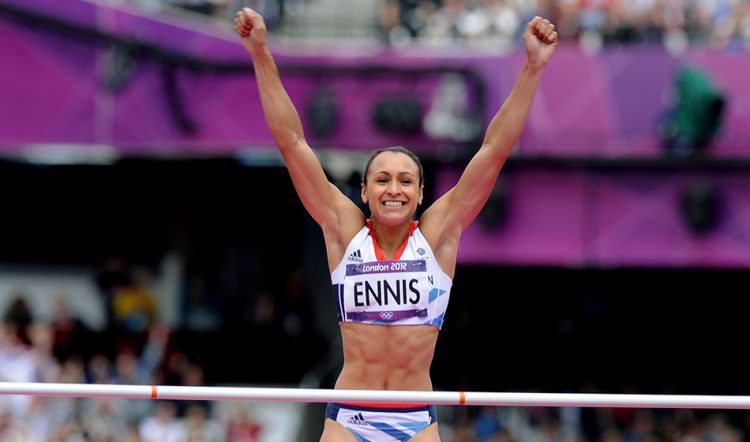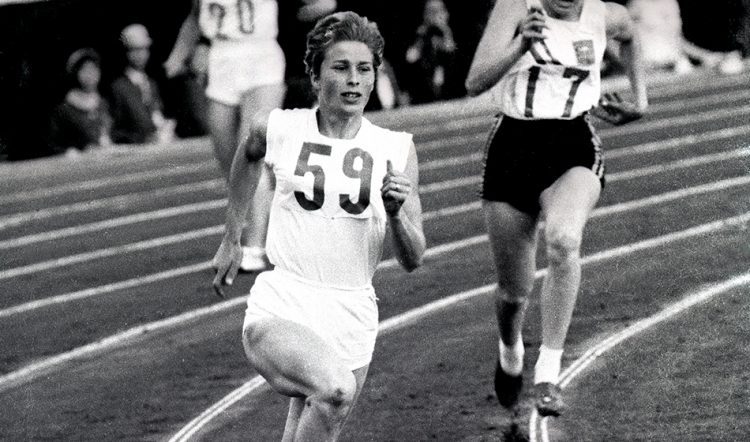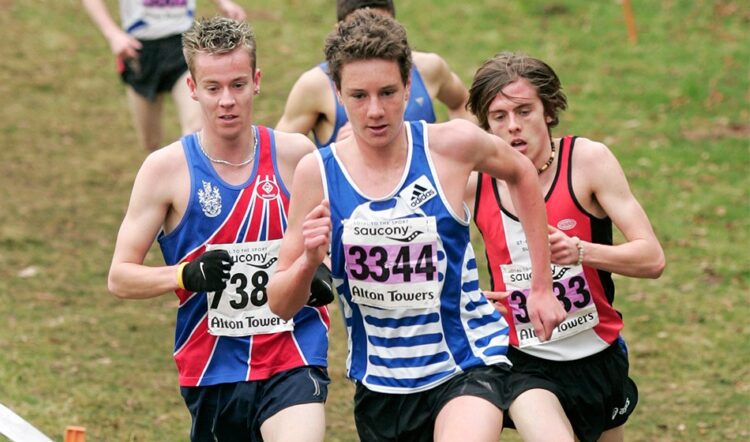We celebrate the centenary of the English Schools Athletics Association and set the scene for what will be a very special edition of the "Kids Olympics" this month
When the traditional Olympic-style ‘parade’ takes place at the English Schools Track and Field Championships at the Alexander Stadium in Birmingham on July 12, it will be like no other in the event’s 100-year history. Uniquely, the class of 2025 will join gold medallists from yesteryear as the champions of the past meet the talented teenagers of today.
It promises to be a proud and emotional moment as multiple generations of English athletes enjoy their moment in the spotlight at a championship which has earned a rich history thanks to a century’s worth of hard work and sacrifice by the school teachers who have volunteered their time to make it happen.
They call it the “Kids Olympics” for a reason. For many it will be the highlight of their life as an athlete, producing fond memories that will last forever. A chosen few will use it as a springboard to even greater things, representing their country at major championships and maybe, for a handful, reaching the podium at the Olympics itself.
Daley Thompson, an English Schools 200m champion in 1975 before going on to become the world’s greatest decathlete, says: "When I was young and growing up everyone wanted to go to the English Schools and win it. It was absolutely and utterly the biggest competition in the whole world for us. I think it holds a very special place in people’s hearts.”
If you include the English Schools championships for cross-country, combined events, race walking and the popular Cup competitions, it is estimated that around 4000 competitors take part each year and around a quarter of a million youngsters have been involved since the English Schools Athletic Association (ESAA) was formed in 1925.

Not only does it act as a breeding ground for future champions, but the events themselves are brilliantly organised. A team of 115 officials will be in Birmingham on July 11-12, for example, striving to maintain the usual high standards that will see athletes across three age groups battling for medals in 98 events, with heats, rounds and finals organised with military precision.
The organisers have also shown the flexibility to react to huge problems over the years. Since the English Schools was born it has negotiated disruptions caused by world war, foot-and-mouth disease and a global pandemic, not to mention the challenging ups and downs caused by various sponsors coming and going.
Seb Coe, who won 3000m gold in Bebington in 1973 before going on to win two Olympic 1500m titles and, of course, becoming president of World Athletics, says: “The ESAA’s programme of three championships across three age groups give many young people their first taster of a big event away from the comfort of their local area and home track. Those championships help build confidence and an understanding of the commitment and hard work that is required to succeed not just in athletics but in life generally.”
For spectators at the English Schools Championships the eye is often drawn to the winner, but sometimes the athletes with the greater potential are a little further down the field. The 1972 English Schools Cross Country Championships at Hillingdon, for instance, saw Coe finish only 10th in the inter boys race with his big rival Steve Ovett finishing runner-up behind the unheralded Kirk Dumpleton.
Such was his all-round talent, Ovett had earlier won the English Schools 400m title in 1970 whereas another supermiler from the same era, Steve Cram, won a hat-trick of 1500m titles from 1977-1979.
Thirteen years before winning Olympic heptathlon gold at London 2012, Jessica Ennis-Hill finished an unnoticed 10th in the junior girls’ high jump at Bury St Edmunds (although she later won English Schools golds). Montell Douglas, who was destined to become UK record-holder at 100m, meanwhile, was only 17th in the same high jump event behind Ennis-Hill in 1999.

Fellow London 2012 champions Mo Farah and Greg Rutherford had mixed fortunes at the English Schools. Farah won several titles on the track and in cross country, whereas Rutherford finished just outside the medals in the long jump several times from 2001-2004.
Fantastic stories over the years include international sprinter Emily Diamond, who maintained a fine family tradition when winning 200m gold at the 2009 English Schools. In the late 1970s her mum, Nicola, won long jump silver medals, whereas her grandmother Valerie Webster won the first of three English Schools titles in the long jump in 1948. What’s more, Valerie met her husband – and Emily’s grandfather, Alan – at the English Schools as he was a 220 yards silver medallist in 1951!
Joe Bugner won the 1964 junior boys discus crown before becoming a heavyweight boxer, where he had high-profile fights against, among others, Muhammad Ali and Henry Cooper.
Perhaps the quirkiest story, though, is Bob Anderson, who won junior boys javelin gold in 1963 before becoming crowned world champion 25 years later in another throwing sport … darts!
For every future superstar like Coe, Farah or Paula Radcliffe – the latter winning English Schools titles in 3000m and cross-country – there are long-forgotten characters like Kevin Steere, a Norfolk athlete whose inter boys 3000m time of 8:20.0 from 1971 remains the oldest championship record in the book, surviving attacks from fellow inter boys 3000m champions like Coe, Farah and Jon Brown over the years.
One thing is sure, though, whether you win or lose you will have memories to last a lifetime. Further, why should national titles earned as a teenager be any less worthy than those won as an adult? After all, English Schools titles are arguably tougher to win than English senior titles due to the sheer number of teenagers involved.

So how did it all begin? “Like all good ideas it started with a discussion in a pub in London,” says Paul Allison, the current chair of the English Schools AA. “Some PE teachers who were involved in club sports and grassroots thought there should be a governing body for schools athletics. Then, after the birth of the organisation, it snowballed.”
On being chair in the centenary years, he adds: “It’s been a privilege. When I was nominated for chair, I didn’t initially realise my second year would be the centenary year. I didn’t do the maths to begin with!”
As part of its centenary celebrations, the ESAA is bringing out a special book on the association’s history written by John Mackie. It is full of stats and stories and among other things impressively delves into the early days of the English Schools. This is no mean feat given the fact the organisation was created 20 years before AW was first published in 1945.
It was on May 16 in 1925 at the Victoria Hotel in London that a “Schools’ Athletic Association” was born. The first championships were for under-14s and saw 13 counties taking part – largely the counties closest to London. There were eight boys events, six for girls and a tug o war! It sounds fairly small but it’s estimated that close to 1000 athletes took part on a wet and windy mid-September day at Crystal Palace.
The idea had the support of members of parliament, aristocrats and even a future king – The Duke of York, who later became King George VI – in addition to help from the Daily Express newspaper. From then on, as Allison says, it snowballed and in 1961 the organisation was renamed the English Schools’ Athletic Association.
In 1933 there were under-16 events added to the programme. In 1936 Dorothy Odam became the first Olympic medallist – as two years earlier she had been a high jump silver medallist for Surrey.
In the mid-1940s the “host and guest” principle was introduced, which many came to refer as billeting. This saw children housed with local families over the championship weekend, although it was eventually phased out in the 1990s as the idea of a child temporarily staying with strangers became increasingly inappropriate.
The tradition of travelling as a county team has endured, though. “We’re very proud of the structure,” says Allison, “where athletes can travel as a county, stay overnight with a county, they make friends with their county and have team managers who have done it for years.”
By 1950 the senior age group was added but, mirroring international athletics generally, the longest event for girls was still only 150 yards. This soon increased to 220 yards, though, before the 880 yards was introduced in 1955.
Alongside the competitions, there were also Easter coaching conferences at Lilleshall from 1951 onwards, giving young athletes exposure to top level coaching.

Meanwhile the number of events began to grow. In 1960 the first boys cross-country championships was held in Speke in Liverpool with the girls championships making its debut in 1968 in Rochdale. Race walking championships were also introduced for boys in 1968 and girls in 1974, with combined events championships arriving in 1988.
In 1961 the first SIAB international schools event took place. “It is often the first step on the track in an international vest for many athletes,” says Allison.
The 1960s also saw the first Olympic champions with an English Schools background crowned. Mary Rand, for example, won the 1964 Olympic long jump crown whereas a few years earlier, competing as Mary Bignal, she represented Somerset at the 1956 English Schools, winning long jump gold, before taking high jump gold in 1957.

At the same Tokyo Olympics, Ann Packer won 800m gold. Yet only five years earlier she was winning the English Schools senior girls 100 yards title for Berkshire.
In total there are 19 English Schools athletes who have gone on to win Olympic athletics gold. Rand and Packer aside, they include Tessa Sanderson, Sally Gunnell, Denise Lewis, Kelly Holmes, Keely Hodgkinson, Linford Christie, Jonathan Edwards, Darren Campbell, Jason Gardener, Marlon Devonish and Mark Lewis-Francis, plus Ennis-Hil Coe, Ovett, Rutherford and Farah and Thompson.
Several more English Schools athletes have also graduated to win world titles, such as Katarina Johnson-Thompson, Fatima Whitbread, Dina Asher-Smith, Phillips Idowu, Derek Redmond and Roger Black to name just a few.

The centenary book author Mackie estimates that 85 per cent of the England athletes who have won British Championship titles since 1960 were former ESAA competitors. With mind boggling stats, he adds: “At the end of 2024 there have been 7660 ESAA Championship titles up for grabs: 3347 for girls, 4293 for boys and 20 mixed gender events.”
Not all great athletes enjoy victories at the English Schools, however. In addition to Ennis-Hill struggling in her early days and Rutherford being beaten at multiple championships, decathlon great Thompson didn’t even do the English Schools Combined Events, focusing on 200m at the track and field championships instead.
Ian Stewart’s only appearance in the English Schools Championships was in the 1964 inter boys cross country race when he finished in 47th for Warwickshire. But he later became world cross-country champion and a European and Commonwealth Games winner on the track, the latter representing Scotland.
Not every English Schools competitor went on to excel in athletics either. Lizzy Yarnold did the English Schools combined events several times representing Kent and was ninth in the javelin but went on to win Winter Olympic skeleton golds in 2014 and 2018.
Not surprisingly, plenty of footballers showed good ability at the English Schools as well. These include goalkeeper David James, centre back Michael Duberry and female players Jill Scott and Lucy Bronze. Similarly, rugby players like recent England captain Maro Itoje have an English Schools background – Itoje being a shot putter for Hertfordshire.
Danny Nightingale competed in the 2000m steeplechase in 1972 before going on to win Olympic team gold in the modern pentathlon in 1976. Helen Glover was an English Schools distance runner before going on to win two Olympic titles in rowing. Alistair Brownlee was an English Schools cross-country champion with his photo featuring prominently in AW before going on to triathlon success in the Olympics with golds in 2012 and 2016.

Proof that athletics is the bedrock of all sports, further Olympic champions with an English Schools background include triathletes Alex Yee, Jonny Brownlee and Georgia Taylor-Brown, hockey players Lily Owsley and Maddie Hinch and cyclist Katy Marchant.
A few English Schools medallists have even gone on to win honours for other countries. Fiona May, for example, won the English Schools long jump title in 1988 and became the first English Schools competitor to win a world junior gold, later that year in Canada. In 1994 she married an Italian pole vaulter, though, before going on to win two world long jump titles for Italy.

During the same period Jon Ridgeon won two sprint hurdles titles at the English Schools before going on to become one of the world’s best athletes. These days he is the chief executive at World Athletics and is planning to represent the governing body in Birmingham this month to official present a World Athletics Heritage plaque which will then be on permanent display at the venue.
On the award, World Athletics president Coe says: “This entirely volunteer-based organisation has done so much to foster a lifelong passion for our sport among generations of young athletes.
“The ESAA provides aspiring athletes with a crucial championship platform to compete against the best in their age group across the nation in the disciplines of cross country running, combined events, race walking and track and field athletics.
“The ESAA has for a century been the bedrock of athletics success in England helping to discover, nurture and develop athletics talent, who go on to become the sport’s senior stars. Long may this incredible athletics success story continue.”

So with just days to go before the centenary event, is there a mad panic? Or is the English Schools operation a well oiled machine?
“There’s always an element of structured panic as there is always something on our ‘to do’ list,” says Allison. “It’s a jigsaw and it always comes together but not really until the Thursday night before it starts.
“We’re really lucky we have people on the committee who have done this a number of times,” he adds.
“I suppose it is a well oiled machine because if it’s not broken then why fix it? But at the same time we do like to tweak some things as well.”
These include allowing a visiting team from the United Arab Emirates to compete, mirroring a tradition from a number of years ago where children from parents working for the armed services overseas were able to come back to England to compete.
Allison adds: “We’re all volunteers giving up a lot of time and also giving back to the sport that they enjoyed. There are a lot of retirees involved and it’s something we’re conscious of as we’re always trying to get young blood into the sport. We do a young officials programme for example where we ask counties to send one or two 14 or 15-year-olds who might not be competing but who can get involved in an event by maybe shadowing an official.”
The English Schools is about helping to mould future champions. But also, it’s clear, it’s about creating memories for thousands of people, from young athletes to officials, who have been part of probably the most cherished event on the English athletics calendar.
What they say…
Dina Asher-Smith
"English Schools was fantastic and I’m really proud to sponsor the girls sprint races - last year and this year. The reason why I do that and why I love the English Schools is because it’s an essential pathway. You’ve seen all of our stars come through whether they’ve gone on to do track or football, cricket, rugby or whatever - loads of people have been to English Schools - it’s such a high calibre competition. It’s a great stepping stone and it’s fun. I remember being so nervous for my first one at Sheffield’s Don Valley. There were so many steps in that stadium - it was almost vertical - and I remember thinking ‘do I have to climb all these steps and then, like, run!? Desiree (Henry) won my first one too (Dina was fifth) and went on to kill it at the World Juniors."
Daley Thompson
"Looking at the previous winners of English Schools that have gone on to the Olympics and the list is endless so it’s really good to note that they’d started their journey at English Schools. It’s the beginning for everybody. This is the greatest athletics championship in the world. Sorry Olympics, but you are a close second! They are also the first port of call for aspiring Olympians."

Keely Hodgkinson
"The English Schools Athletics Association Championships was always the first thing I would put on my annual competition calendar each year as a young developing athlete. It’s basically the Olympics for kids! I loved my experience at this competition over the years. It was the first time I felt like a real athlete as we stayed overnight with the team and I had to learn how to prepare for heats and finals. I also had to learn new skills like knowing when to focus and when to relax, when to eat and what to eat and to communicate with others and make new friends. All these things have stood me in good stead for when I then went on to represent Great Britain & NI at junior level and then senior teams. The English Schools 'Kids' Olympics' fuelled my desire to make the actual Olympics.”
Seb Coe
"The ESAA has for a century been the bedrock of athletics success in England helping to discover, nurture and develop athletics talent, who go on to become the sport’s senior stars."
George Mills
"At that point in time, it's like the biggest thing in the world for you. It teaches you a lot, because championships are all the same, really – it just depends on the level and stage of your career that you're at – so it gives you a lot of experience and definitely has given me a platform to work on and build on to where I am today."
The English Schools champions who struck Olympic athletics gold
Mary Rand – Tokyo 1964, Long Jump
Ann Packer – Tokyo 1964, 800m
Steve Ovett – Moscow 1980, 800m
Seb Coe – Moscow 1980, LA 1984, 1500m
Daley Thompson – Moscow 1980, LA 1984, decathlon
Tessa Sanderson – LA 1984, Javelin
Linford Christie – Barcelona 1992, 100m
Sally Gunnell – Barcelona 1992, 400m hurdles
Jonathan Edwards – Sydney 2000, triple jump
Denise Lewis – Sydney 2000, heptathlon
Kelly Holmes – Athens 2004, 800m and 1500m
Darren Campbell, Jason Gardener, Marlon Devonish and Mark Lewis-Francis – Athens 2004, 4x100m relay
Jessica Ennis-Hill – London 2012, heptathlon
Greg Rutherford – London 2012, long jump
Mo Farah – London 2012 and Rio 2016, 5000m and 10,000m
Keely Hodgkinson – Paris 2024, 800m

Read all about it
ESAA – The First 100 Years, by John Mackie with with a foreword by Sebastian Coe, is a highly recommended read and available via esaa.org.uk/merchandise
You can also buy tickets for this year’s track and field championships on July 11-12 here
